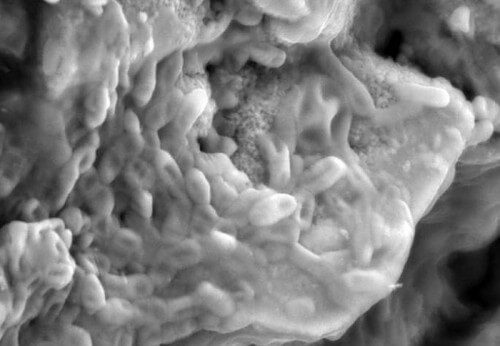Jurassic World, the version of reality: we cannot of course extract DNA from the stone, but at least we can see what dinosaur cells looked like, even from specimens that were not well preserved and which reside in the basements of the Natural History Museum in London

The dinosaurs returned to the headlines thanks to the movie "Jurassic World", but in science they don't wait for the movies and continue to study the remains of the dinosaurs. Scientists have discovered remains with some similarities to red blood cells and collagen fibers in fossilized dinosaur remains. Of course these are fossilized remains and not the tissues themselves.
A team from Imperial College London has identified what appear to be soft tissue remains in fossil fragments of a 75-million-year-old dinosaur, despite the fossils being poorly preserved. So far, soft tissue remains have been found in exceptionally well-preserved dinosaur fossils, and they are very rare and their number is much smaller.
"We still need to do more research to confirm that what we are seeing in the imaging of these dinosaur bone fragments are soft tissue structures. If indeed this is the case, these are the oldest tissue structures discovered and bear some similarities to red blood cells and collagen fibers." says the main researcher, Dr. Sergio Bertazzo.
In their study, published in the journal Nature Communications, the researchers claim that the discovery may cause paleontologists to rethink how fossils are preserved, and it may be the first step towards a better understanding of the biology of dinosaurs and the relationships between their different species.
As part of the research, team members analyzed eight fossil fragments discovered over a century ago and kept in the Sternberg and Cutler collections of the Natural History Museum in London.
The researchers examined part of a fossilized dinosaur claw and identified tiny egg-like structures with a dense inner core. According to them, these structures may be red blood cells, although they clarify that further proof is required to examine whether the findings have another interpretation. Their hope is that if red blood cells can be found in fossil fragments, which are very common, it could help scientists understand whether dinosaurs developed a warm-blooded metabolism like the birds they descended from.
In a fossil fragment of one dinosaur, the team members found structures that appear to be fibers that have joined together into several bands, a structure similar to the collagen fibers seen in modern animals. The structure of collagen varies between different groups of animals, and is a kind of fingerprint for the evolutionary relationship between different creatures. If confirmed, the identification of these collagen-like structures could provide a new independent line of evidence for the family relationship between the dinosaur groups.
Study author Dr. Sergio Bertazzo, a research fellow from the Department of Materials at Imperial College London, said: "We still need to carry out further studies to confirm the discoveries of blood cells and collagen fibers. If we can confirm the correctness of these observations, we will be able to yield new insights into how the dinosaurs lived and developed."
Dr. Suzanne Maidment, a research fellow from the Department of Earth Sciences and Engineering at Imperial College London, and a research partner added: "Our study helps to show that soft tissue preservation may be more common in dinosaur fossils than we thought until now. Although the remains of soft tissues in the past have been discovered in rare, exceptionally preserved fossils. What is particularly exciting about our research is that we discovered the blood cell-like structures and collagen fibers in six poorly preserved fossils. Early signs indicate that even poorly preserved fossils may be useful in putting the pieces of the dinosaur puzzle together and help us understand in more detail how dinosaurs evolved into warm-blooded creatures, and the set of connections between the different species of dinosaurs."
To carry out the research, the staff members used a variety of techniques. The first involved using a scanning electron microscope to examine the structure, composition and location of the soft tissue within the dinosaur fossil fragments. The team members then used a focused ion beam to cut samples and examine the internal structure of the fossils. They tested using a transmission electron microscope to identify the fibrous structures.
Today's birds are distant relatives of the dinosaurs, so the researchers used a mass spectrometer to compare their ancient soft tissues with a blood sample taken from their mother. This allowed them to compare the samples and discover in them some similarities to the organic signatures of the blood cells in the blood sample in the EU databases.
In the next step, the researchers will look for these structures in a wider variety of dinosaur fossil samples also to understand how widespread this type of soft tissue preservation is, until what period it will be possible to extract soft tissue samples and what are the circumstances of the events that made the preservation possible.
For the announcement of the researchers on the Imperial College website
